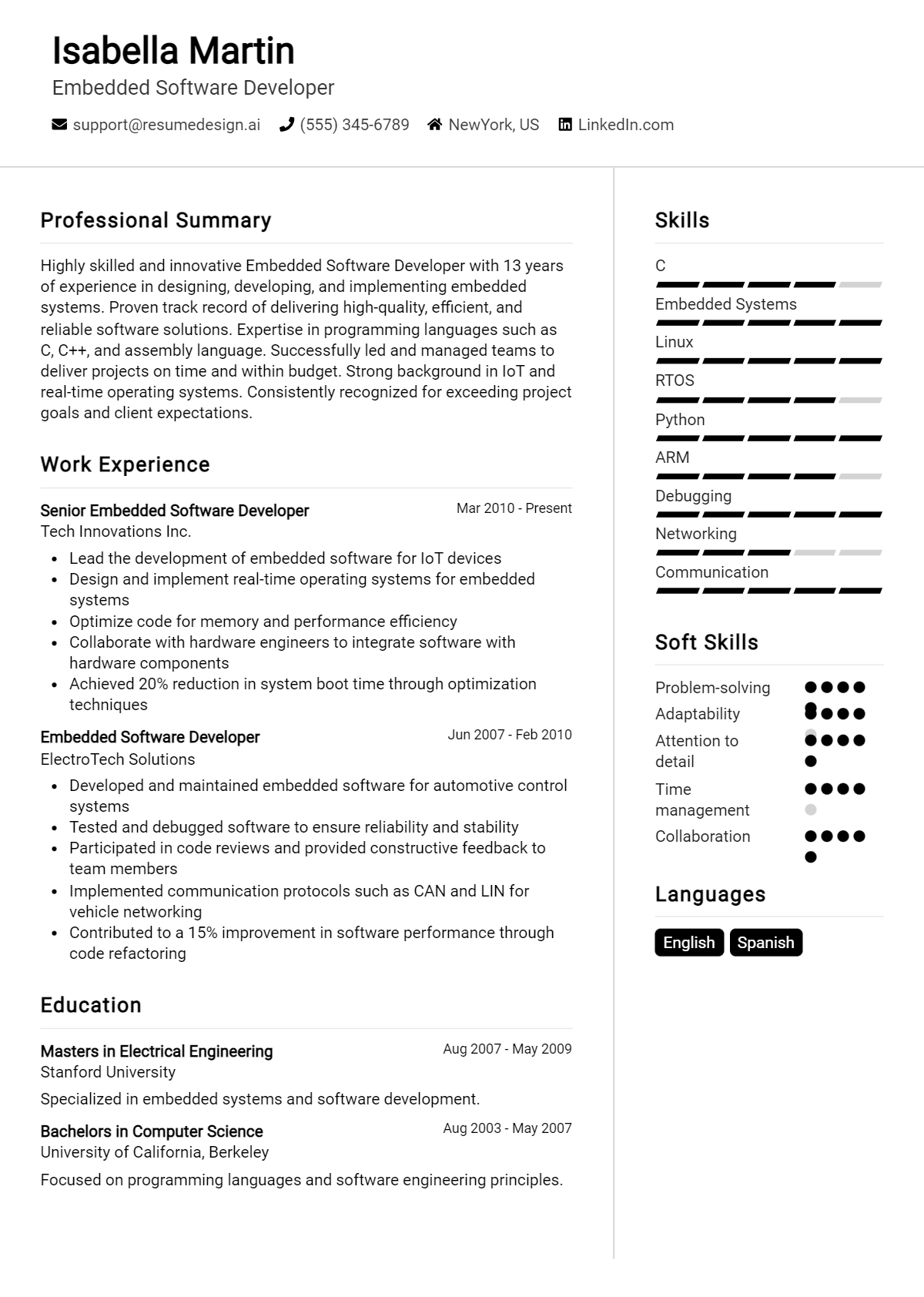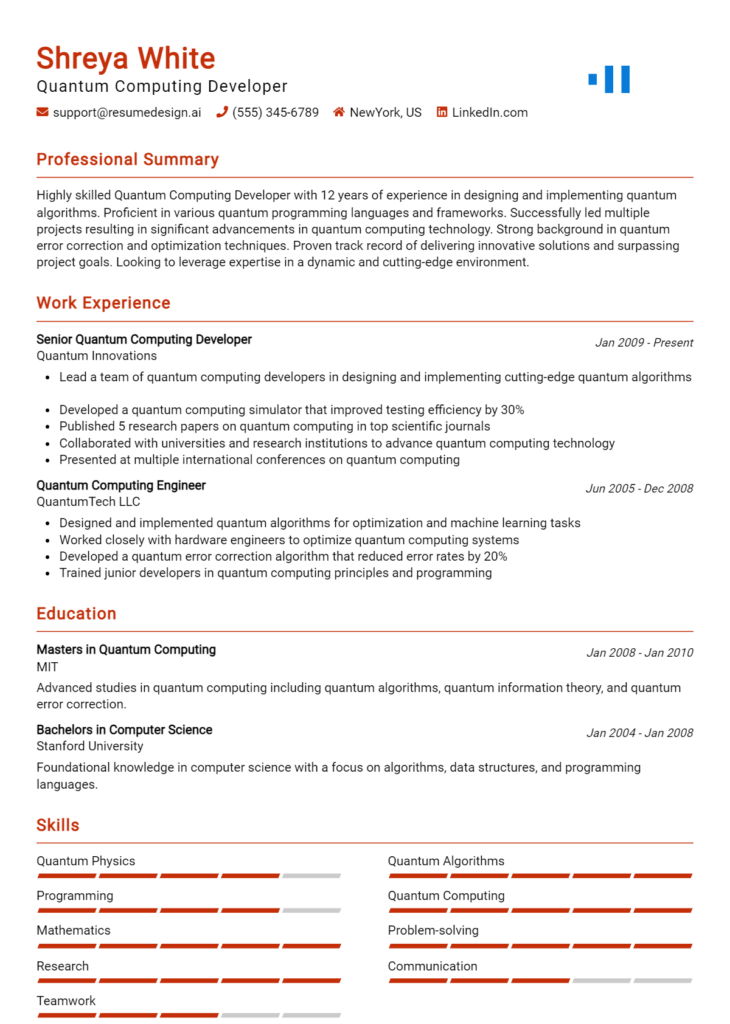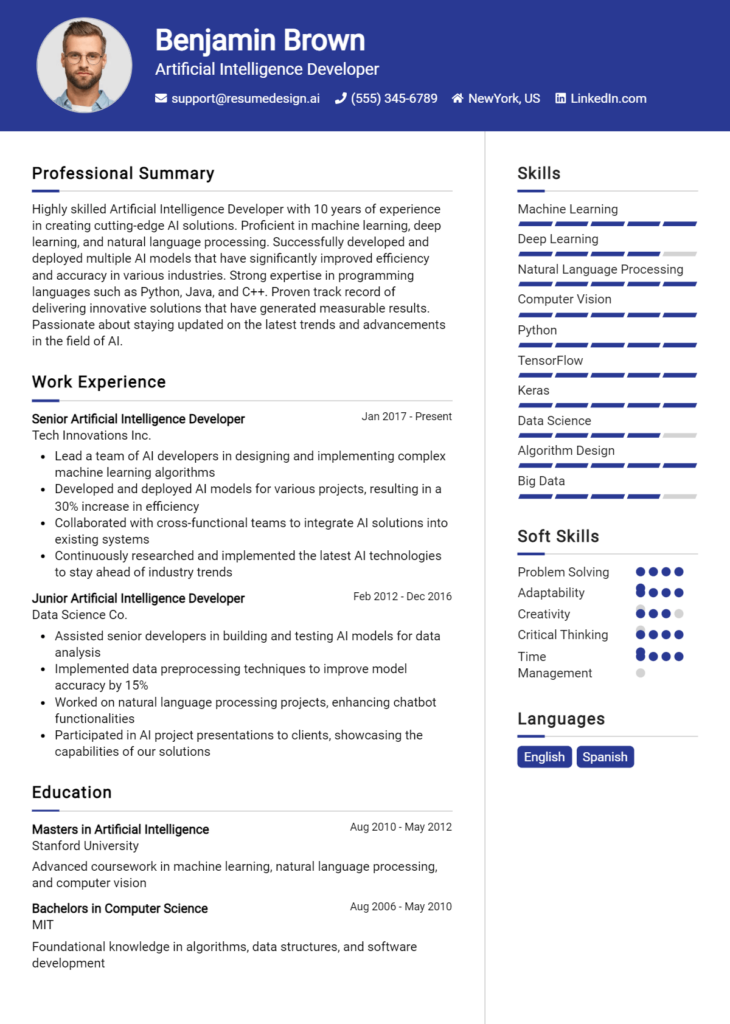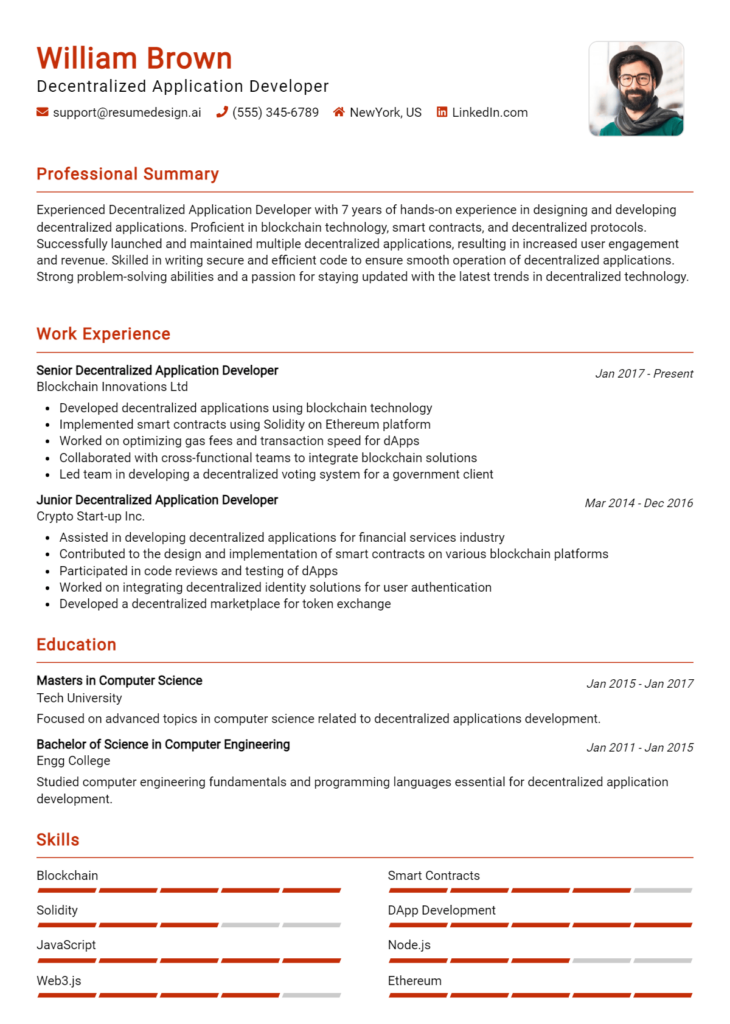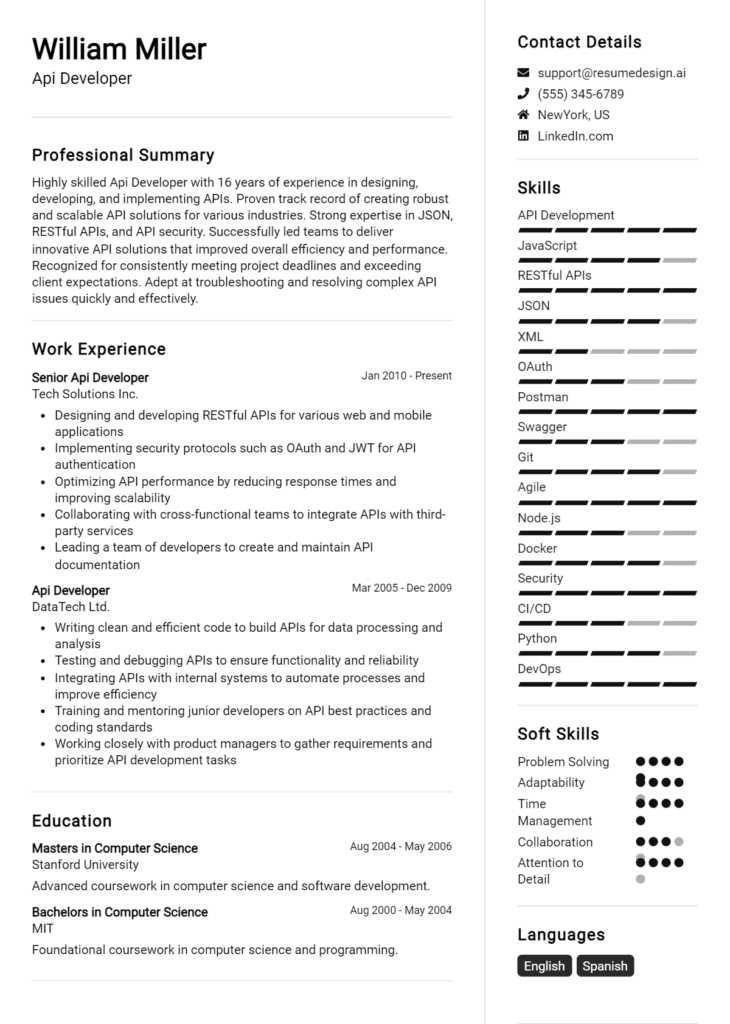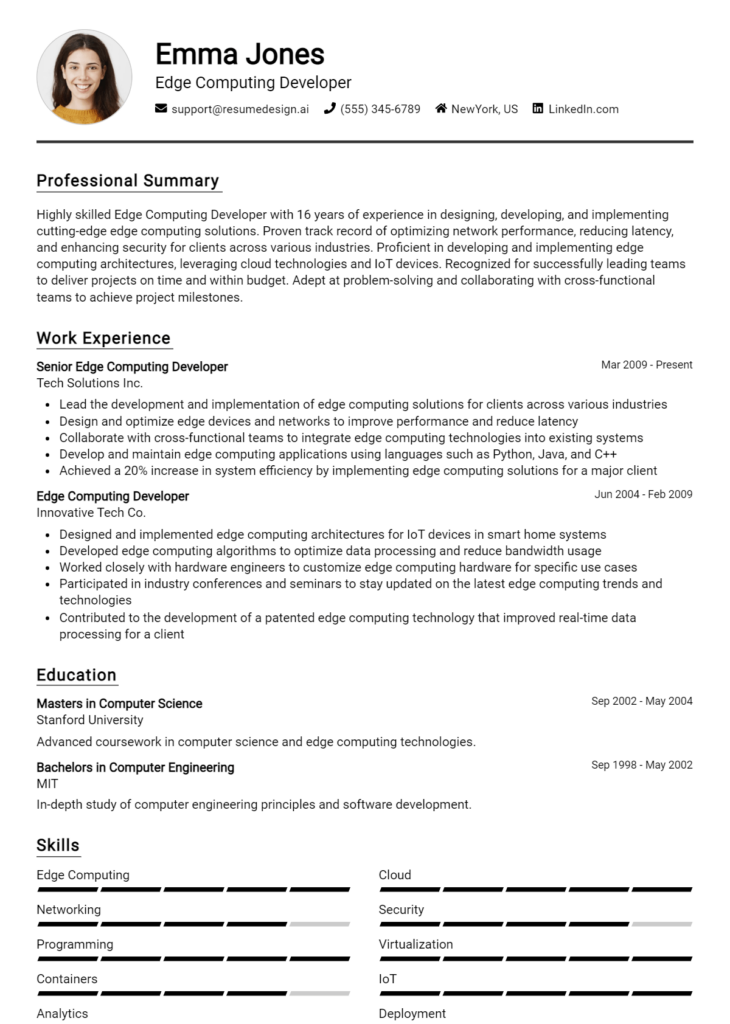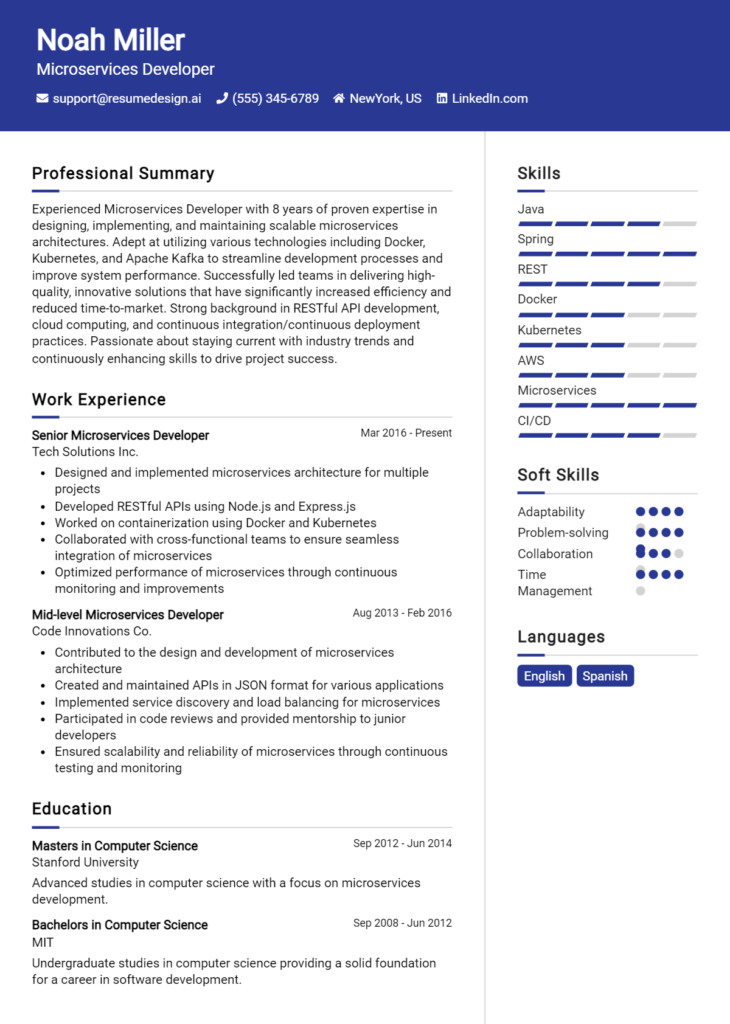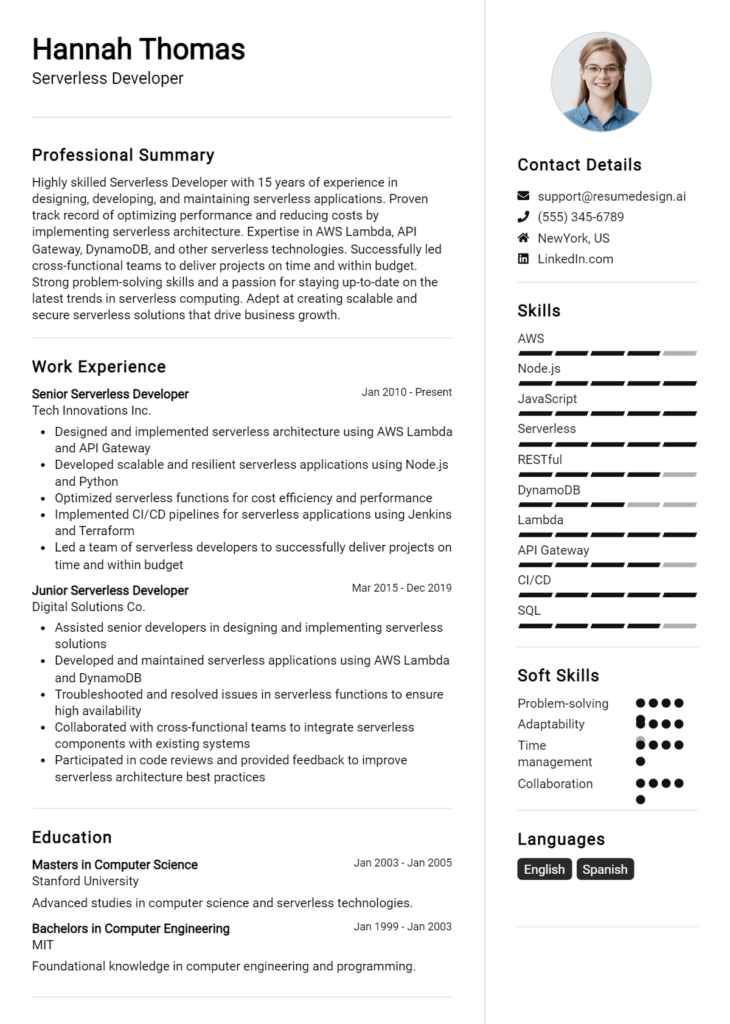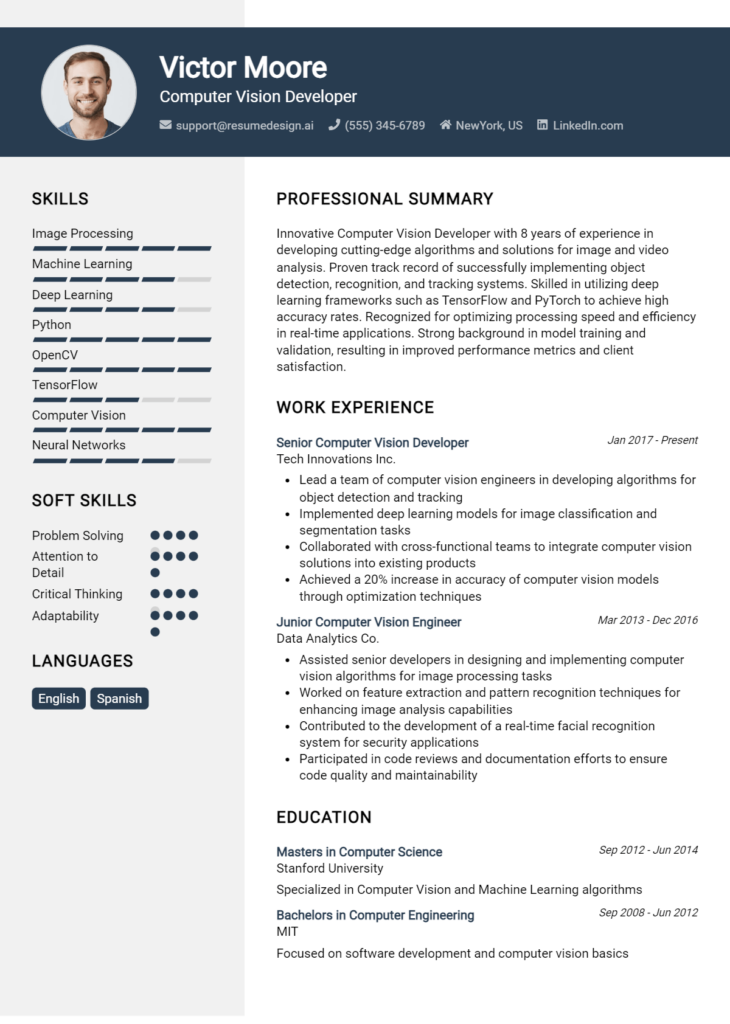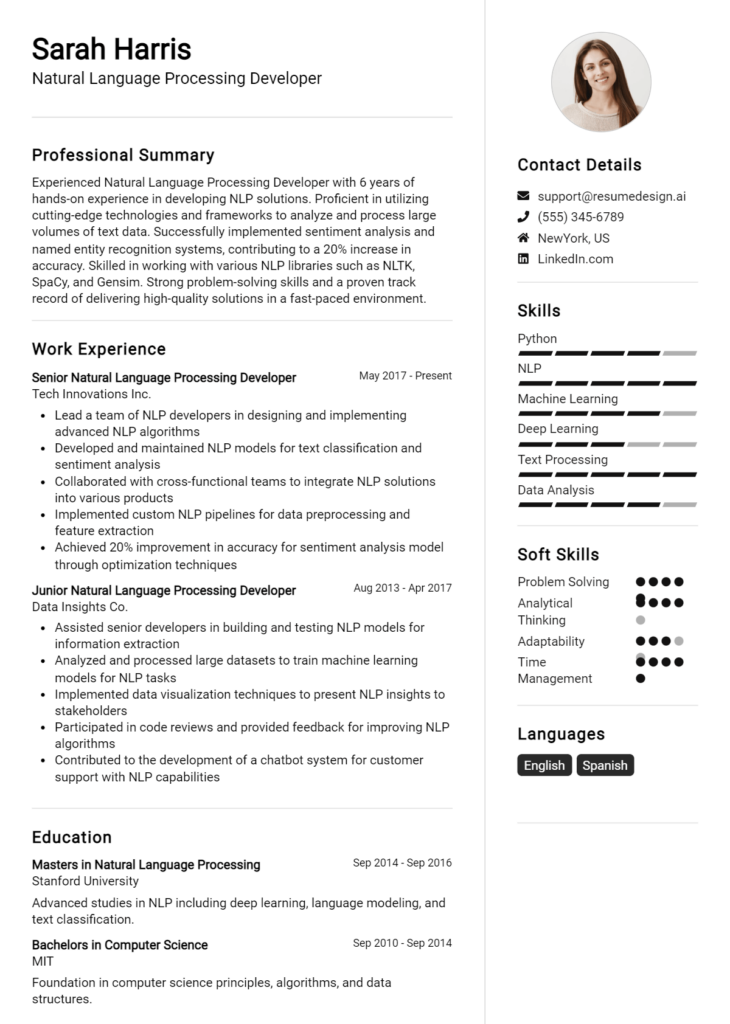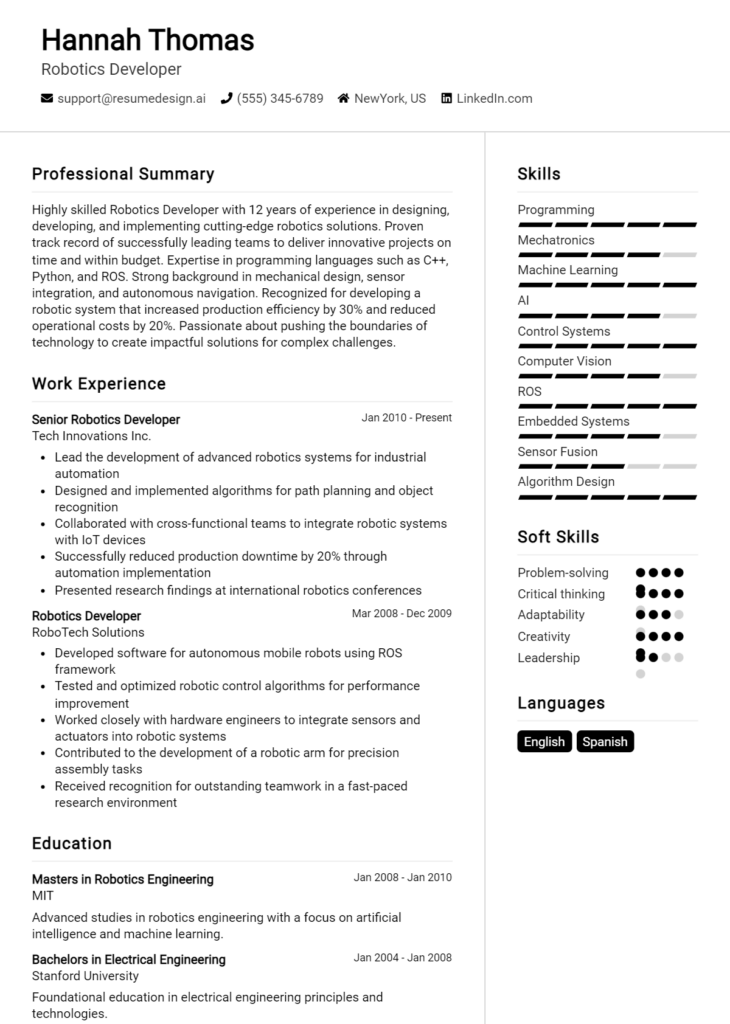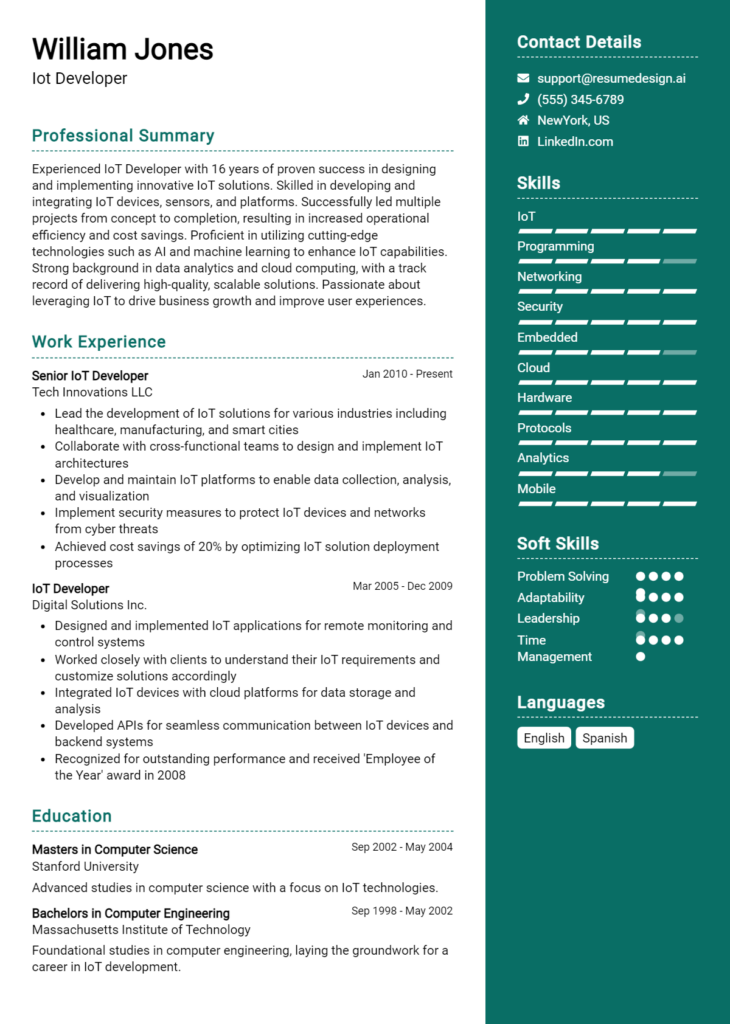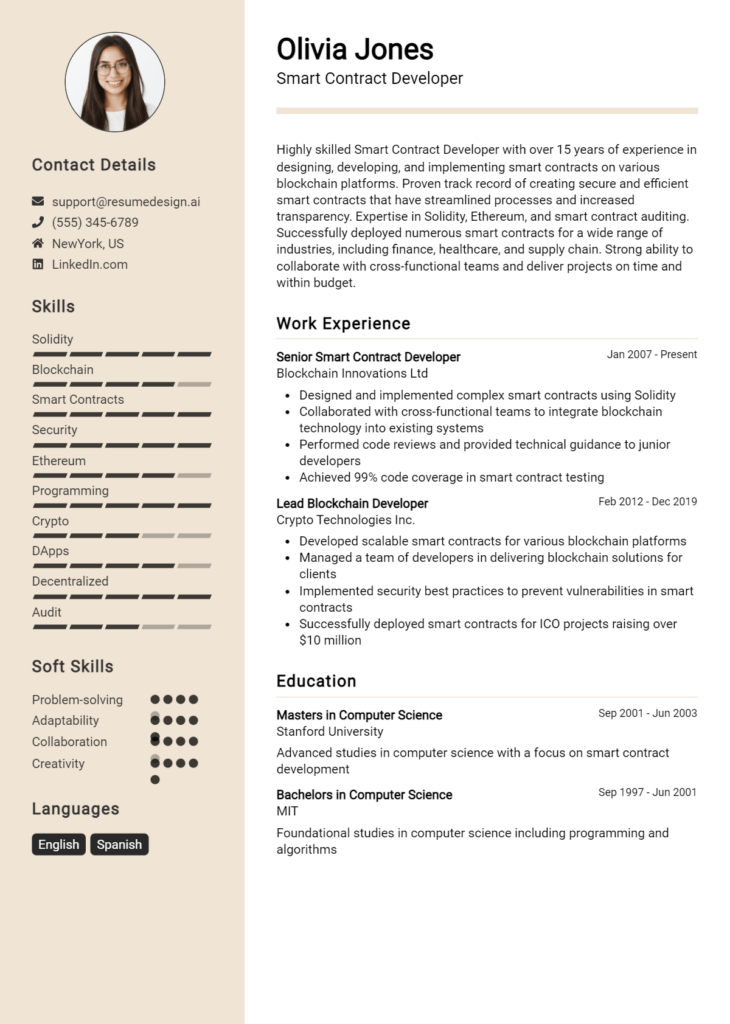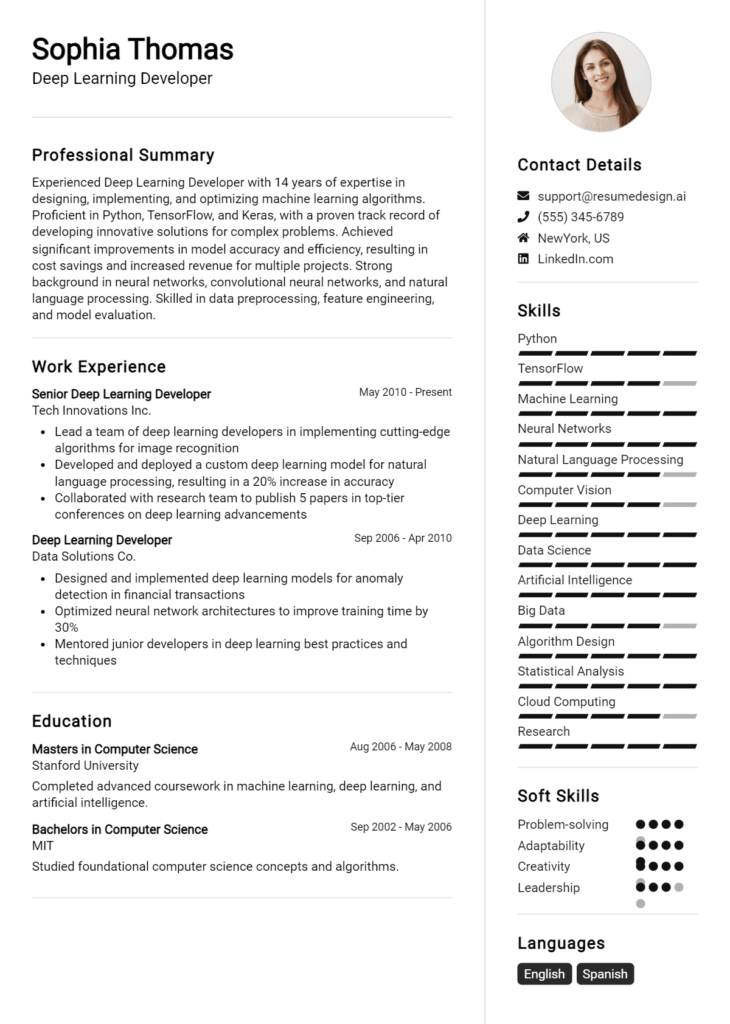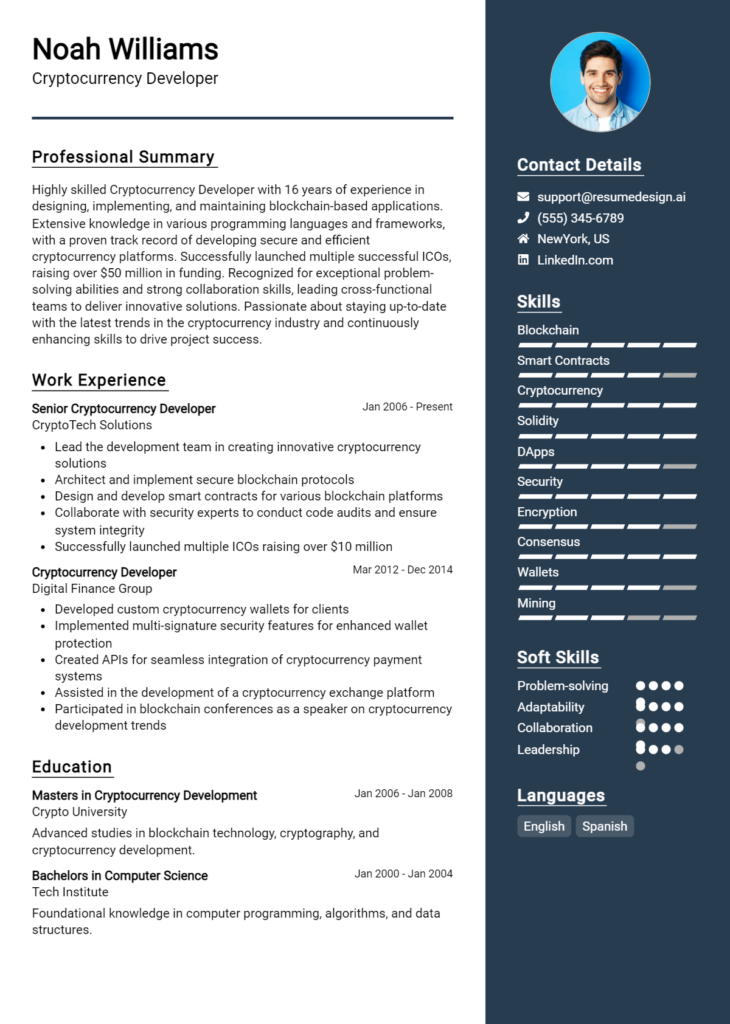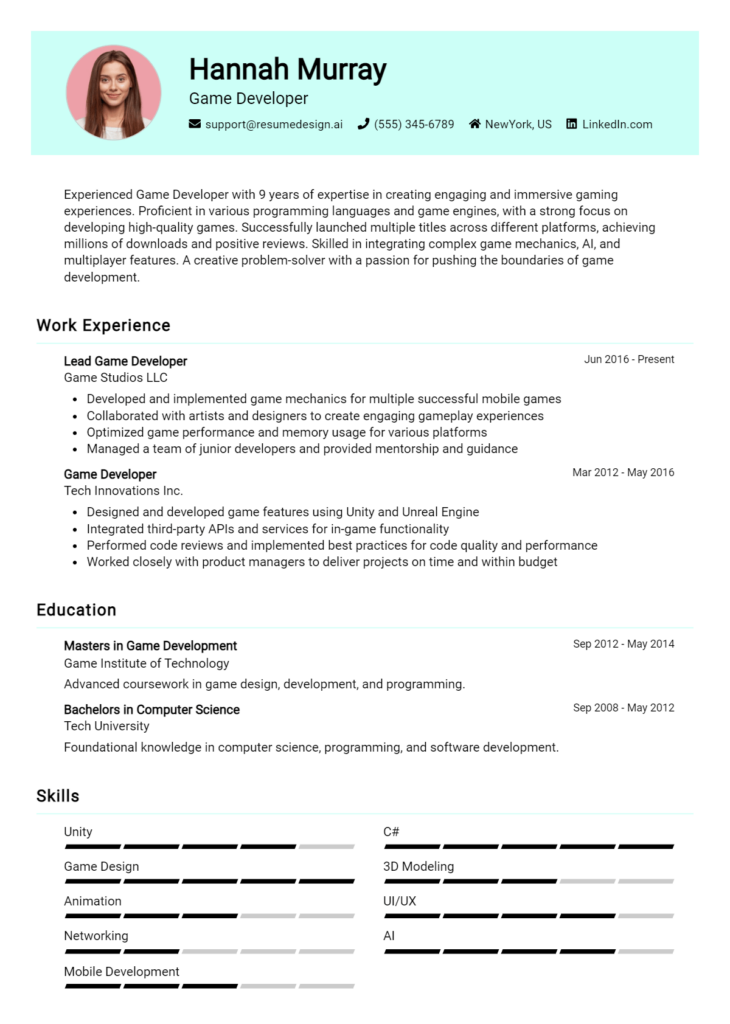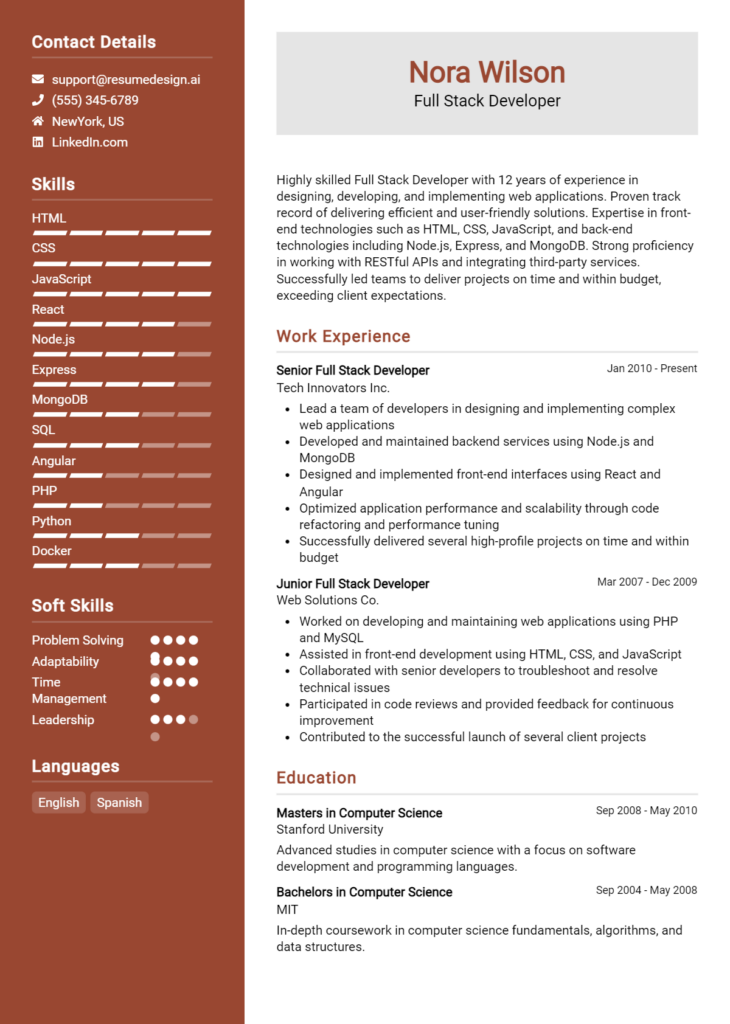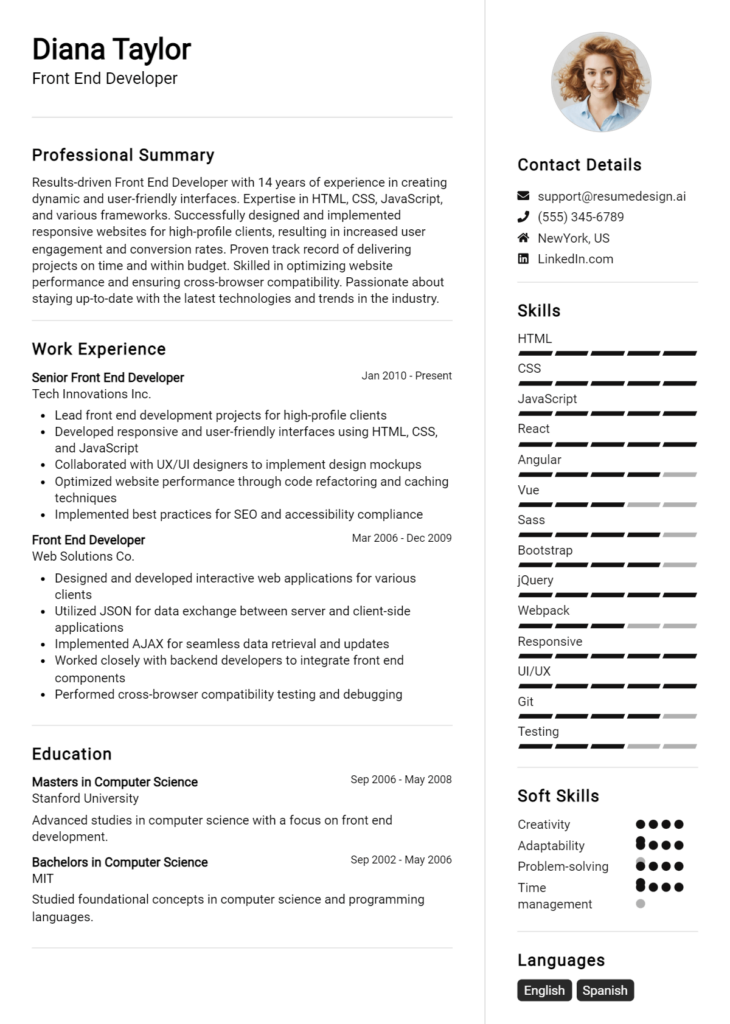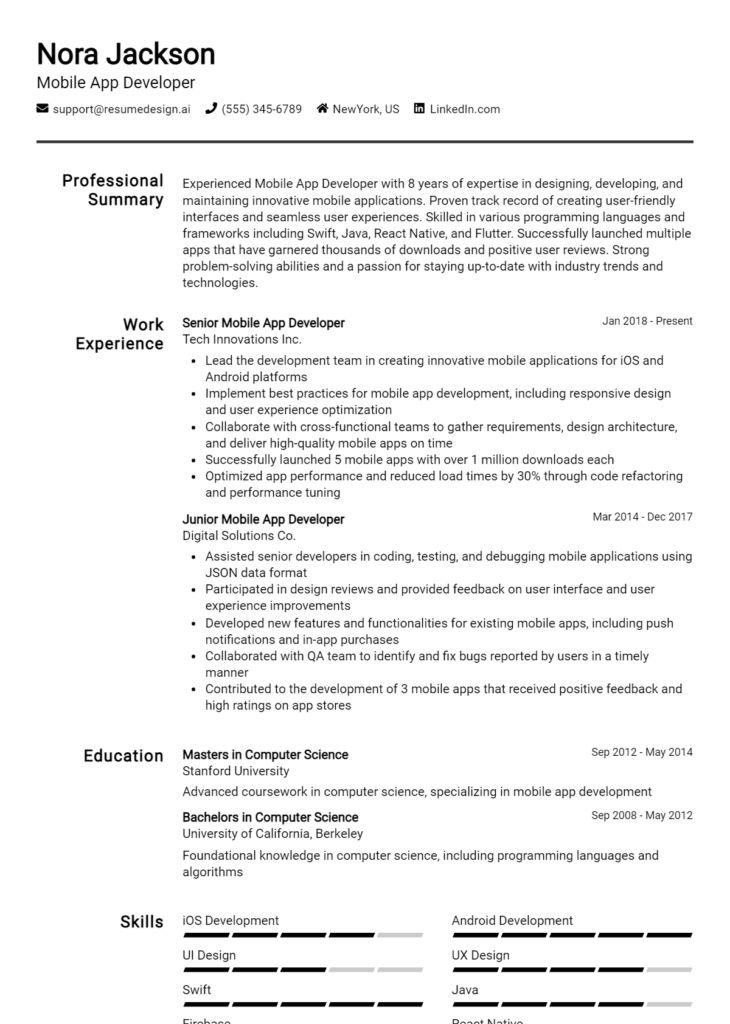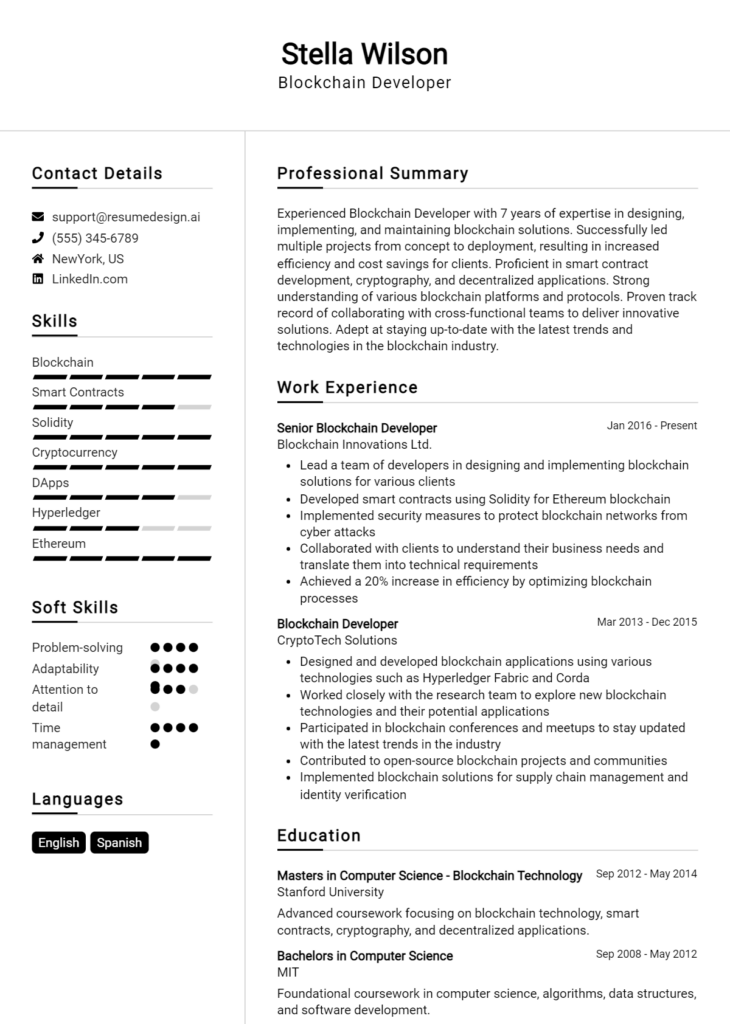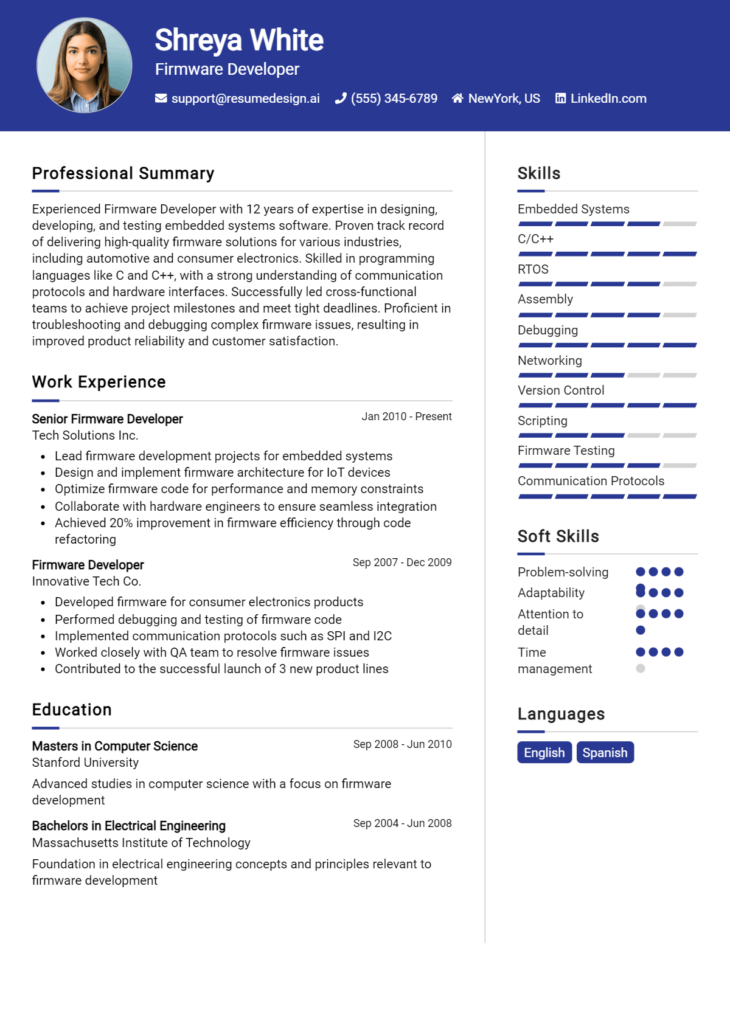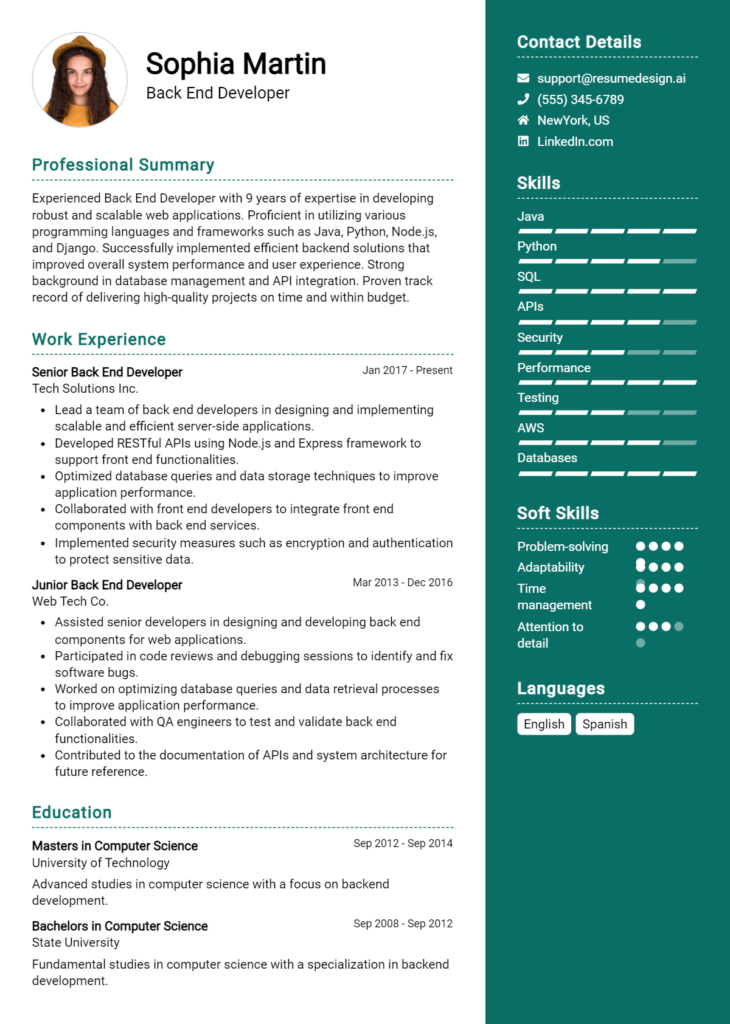Embedded Software Developer Core Responsibilities
Embedded Software Developers play a crucial role in designing, developing, and testing software for embedded systems, bridging the gap between hardware and software departments. They require strong technical skills in programming languages such as C/C++, along with operational expertise in debugging and optimization. Problem-solving abilities are essential for troubleshooting issues that arise during development, ensuring the software meets organizational goals. A well-structured resume effectively highlights these qualifications, showcasing the candidate’s ability to contribute to team success.
Common Responsibilities Listed on Embedded Software Developer Resume
- Design and implement embedded software solutions for various applications.
- Develop and maintain firmware for microcontrollers and processors.
- Conduct rigorous testing and debugging of embedded systems.
- Collaborate with hardware engineers to ensure seamless integration.
- Optimize software performance and memory usage.
- Document software design processes and maintain code repositories.
- Participate in code reviews and provide constructive feedback.
- Stay updated with the latest industry trends and technologies.
- Troubleshoot and resolve software-related issues in a timely manner.
- Assist in developing project specifications and timelines.
- Ensure compliance with industry standards and best practices.
High-Level Resume Tips for Embedded Software Developer Professionals
In the competitive landscape of embedded software development, a well-crafted resume is not just a formality; it is often the first impression you make on a potential employer. Your resume serves as a powerful marketing tool that should encapsulate your skills, achievements, and technical expertise in a manner that resonates with hiring managers. For Embedded Software Developer professionals, it is essential to highlight not only your programming prowess but also your experience in developing embedded systems, your problem-solving abilities, and your contributions to past projects. This guide will provide practical and actionable resume tips specifically tailored for Embedded Software Developer professionals, helping you create a standout resume that opens doors to exciting career opportunities.
Top Resume Tips for Embedded Software Developer Professionals
- Tailor your resume to the job description by incorporating relevant keywords and phrases that reflect the specific skills and experiences the employer is seeking.
- Showcase relevant experience prominently, focusing on projects that highlight your expertise in embedded systems, hardware-software integration, and real-time operating systems.
- Quantify your achievements by including metrics, such as the performance improvements you delivered or the percentage of bugs reduced in your code.
- Highlight industry-specific skills such as proficiency in C/C++, assembly language, and familiarity with microcontrollers and development tools.
- Include any relevant certifications or training that demonstrate your commitment to professional development and expertise in embedded systems.
- Utilize a clear and organized format that enhances readability, using bullet points for easy scanning and clear section headings.
- Incorporate a summary or objective statement that succinctly outlines your career goals and what you bring to the table as an Embedded Software Developer.
- Emphasize collaboration and communication skills, as working in teams and interacting with cross-functional groups are critical in embedded system projects.
- Add links to your GitHub or other repositories where you have demonstrated your coding skills through personal or collaborative projects.
- Keep your resume concise, ideally no longer than one page, focusing on the most relevant information that aligns with the job you're applying for.
By implementing these tips, you can significantly enhance your resume's effectiveness, making it more likely to capture the attention of hiring managers in the embedded software development field. A polished resume that accurately reflects your skills and achievements can increase your chances of landing an interview and, ultimately, securing your desired position in this dynamic industry.
Why Resume Headlines & Titles are Important for Embedded Software Developer
In the competitive field of embedded software development, having a strong resume headline or title is crucial for standing out to hiring managers. A well-crafted headline can capture attention immediately, summarizing a candidate's key qualifications in a single impactful phrase. This concise and relevant summary not only highlights the applicant's expertise but also aligns with the specific requirements of the job being applied for. By effectively showcasing their core skills and experience, candidates can make a memorable first impression that encourages hiring managers to delve deeper into their resumes.
Best Practices for Crafting Resume Headlines for Embedded Software Developer
- Keep it concise: Aim for a headline that is brief yet informative, ideally one to two lines long.
- Be role-specific: Tailor the headline to reflect the specific position you are applying for, using relevant keywords.
- Highlight key skills: Include your most important technical skills or areas of expertise that align with the job description.
- Showcase experience: If applicable, mention years of experience or notable achievements directly related to embedded software development.
- Use action-oriented language: Employ strong verbs and descriptive phrases that demonstrate your proactive approach and contributions.
- Avoid jargon: While technical terms are important, ensure that your headline remains accessible and understandable.
- Make it relevant: Ensure that the headline directly relates to the position and the company’s needs.
- Revise for clarity: After drafting your headline, review it to ensure clarity and impact, eliminating any ambiguity.
Example Resume Headlines for Embedded Software Developer
Strong Resume Headlines
"Innovative Embedded Software Developer with 5+ Years of Experience in IoT Solutions"
“Proficient C/C++ Developer Specializing in Real-Time Operating Systems for Automotive Applications”
“Results-Driven Embedded Engineer with Expertise in Firmware Development and Hardware Integration”
“Dynamic Software Developer with Proven Track Record in Low-Level Programming and Algorithm Optimization”
Weak Resume Headlines
“Software Developer”
“Experienced Programmer Looking for Opportunities”
The strong headlines are effective because they are specific, highlighting key qualifications and areas of expertise that resonate with the embedded software development role. They provide clear insight into the candidate's background and skills, making an immediate impact. In contrast, the weak headlines fail to impress as they lack specificity and do not convey any unique attributes or achievements, leaving hiring managers with little reason to explore further. By crafting targeted and compelling headlines, candidates can significantly enhance their chances of being noticed in a crowded job market.
Writing an Exceptional Embedded Software Developer Resume Summary
A resume summary serves as the gateway to an Embedded Software Developer's qualifications, acting as a concise introduction that immediately captures the attention of hiring managers. In a competitive job market, a strong summary highlights key skills, relevant experience, and notable accomplishments in a way that aligns with the specific role being applied for. By distilling complex achievements into impactful statements, candidates can effectively demonstrate their value and expertise, making it easier for hiring managers to see the potential fit for their teams. A well-crafted summary should be concise, impactful, and tailored to resonate with the job description, ensuring the candidate stands out among the myriad of applications.
Best Practices for Writing a Embedded Software Developer Resume Summary
- Quantify achievements to provide concrete evidence of your impact.
- Focus on relevant skills that align with the job description.
- Tailor your summary for each application to reflect the specific requirements of the role.
- Use industry-specific terminology to resonate with hiring managers.
- Highlight specific programming languages, tools, and technologies you are proficient in.
- Keep it concise, ideally within 2-4 sentences, to maintain clarity and focus.
- Showcase your problem-solving abilities and innovative contributions in previous roles.
- Avoid generic phrases; instead, use dynamic language that reflects your passion and expertise.
Example Embedded Software Developer Resume Summaries
Strong Resume Summaries
Results-driven Embedded Software Developer with over 5 years of experience in designing and implementing software for real-time systems. Spearheaded a project that enhanced system performance by 30% through optimized code and efficient resource management.
Detail-oriented Embedded Software Engineer skilled in C/C++ and Python, with a proven track record of developing firmware for IoT devices. Successfully reduced power consumption by 20% in the latest product line, contributing to a significant cost reduction for the company.
Innovative Embedded Systems Developer with a background in robotics and automation, experienced in leading cross-functional teams to deliver complex projects on time. Developed a proprietary algorithm that improved object detection accuracy by 15%, enhancing overall system reliability.
Weak Resume Summaries
Experienced software developer looking for a new opportunity in embedded systems.
I have skills in programming and enjoy working on various projects related to software development.
The examples provided demonstrate a clear distinction between strong and weak resume summaries. Strong summaries effectively quantify achievements, specify relevant skills, and showcase direct applicability to the role, making them compelling to hiring managers. In contrast, weak summaries are vague, lack measurable outcomes, and appear too generic, failing to provide any real insight into the candidate's qualifications or potential contributions.
Work Experience Section for Embedded Software Developer Resume
The work experience section of an Embedded Software Developer resume is crucial as it serves as a testament to the candidate's technical skills and professional journey. This section not only highlights the candidate's ability to design and implement complex embedded systems but also showcases their experience in managing teams and delivering high-quality products that meet industry standards. By quantifying achievements and aligning work experiences with industry expectations, candidates can effectively demonstrate their value to potential employers, making this section a key focal point in a competitive job market.
Best Practices for Embedded Software Developer Work Experience
- Use clear and concise language to describe your roles and responsibilities.
- Quantify your achievements with metrics, such as performance improvements or project completion times.
- Tailor your experiences to align with the specific requirements of the job you are applying for.
- Highlight relevant technical skills and tools, using industry-standard terminology.
- Emphasize your collaboration and teamwork capabilities, mentioning cross-functional projects.
- Include leadership experiences where you guided teams or mentored junior developers.
- Showcase problem-solving skills by detailing how you overcame specific technical challenges.
- Maintain a chronological order to provide a clear timeline of your career progression.
Example Work Experiences for Embedded Software Developer
Strong Experiences
- Led a team of 5 developers in the design and implementation of a real-time embedded system that reduced latency by 30%, resulting in a 15% increase in customer satisfaction.
- Developed and optimized firmware for a medical device, achieving compliance with FDA regulations and contributing to a successful product launch within deadline.
- Collaborated with hardware engineers to integrate a new communication protocol, which improved data transmission efficiency by 40%.
- Mentored junior developers, enhancing their coding skills and contributing to a 25% reduction in code review time.
Weak Experiences
- Worked on various embedded software projects.
- Participated in team meetings and discussions regarding project development.
- Helped with debugging and testing software.
- Contributed to a project that involved embedded systems.
The strong experiences are considered effective because they provide specific details about the candidate's contributions, quantifiable outcomes, and demonstrate leadership and collaboration. In contrast, the weak experiences lack specificity and fail to highlight impactful results or technical skills, making them less memorable to potential employers. By focusing on clear, quantifiable achievements, candidates can make a more compelling case for their qualifications in the field of embedded software development.
Education and Certifications Section for Embedded Software Developer Resume
The education and certifications section of an Embedded Software Developer resume plays a critical role in showcasing a candidate's academic foundation and commitment to ongoing professional development. In an industry where technology rapidly evolves, highlighting relevant degrees, industry-recognized certifications, and specialized training not only reinforces a candidate's technical proficiency but also demonstrates their dedication to continuous learning. This section serves as a platform to detail coursework that directly aligns with embedded systems, enhancing credibility and making a strong case for the candidate's suitability for the role.
Best Practices for Embedded Software Developer Education and Certifications
- Include relevant degrees in Computer Science, Electrical Engineering, or related fields.
- List industry-recognized certifications such as Certified Embedded Systems Engineer (CESE) or similar credentials.
- Highlight specialized training or workshops attended that pertain directly to embedded systems development.
- Provide a brief overview of relevant coursework that emphasizes key skills and knowledge areas.
- Maintain a clear and concise format, ensuring easy readability and quick reference for hiring managers.
- Keep the section updated with the latest certifications and educational achievements.
- Consider including online courses or boot camps that demonstrate commitment to learning new technologies.
- Use bullet points to clearly delineate each entry for better visual impact.
Example Education and Certifications for Embedded Software Developer
Strong Examples
- Bachelor of Science in Electrical Engineering, University of Technology, 2020
- Certified Embedded Systems Engineer (CESE), 2022
- Advanced Embedded Programming Course, Online Learning Platform, 2023
- Relevant Coursework: Microcontroller Programming, Real-Time Operating Systems, and Embedded Systems Design
Weak Examples
- Bachelor of Arts in English Literature, University of Arts, 2019
- Certification in General IT Skills, 2015
- Basic Computer Programming Course, Community College, 2018
- High School Diploma, 2016
The strong examples are considered effective because they directly relate to the qualifications and skills required for an Embedded Software Developer role, showcasing relevant degrees and certifications that enhance the candidate's profile. In contrast, the weak examples fail to connect with the specific demands of the position, highlighting either irrelevant fields of study or outdated certifications that do not align with current industry standards. This distinction emphasizes the importance of tailoring the education and certifications section to reflect qualifications that are applicable and valuable to prospective employers.
Top Skills & Keywords for Embedded Software Developer Resume
As an Embedded Software Developer, showcasing the right skills on your resume is crucial for standing out in a competitive job market. Employers are keen to identify candidates who not only possess the technical expertise but also the interpersonal skills necessary to thrive in collaborative environments. A well-rounded skill set not only highlights your qualifications but also demonstrates your ability to adapt to various challenges in embedded systems development. By emphasizing both hard and soft skills, you can create a compelling narrative that resonates with potential employers and aligns with their expectations.
Top Hard & Soft Skills for Embedded Software Developer
Soft Skills
- Problem-solving
- Team collaboration
- Communication skills
- Time management
- Adaptability
- Critical thinking
- Attention to detail
- Creativity
- Initiative
- Passion for learning
Hard Skills
- Proficiency in C/C++ programming
- Embedded systems design
- Real-time operating systems (RTOS)
- Microcontroller architectures
- Hardware-software integration
- Debugging and troubleshooting
- Knowledge of communication protocols (e.g., I2C, SPI, UART)
- Familiarity with IDEs and version control systems (e.g., Git)
- Understanding of digital and analog electronics
- Experience with software development lifecycle (SDLC)
By carefully curating your skills and effectively showcasing your work experience, you can improve your chances of landing an interview and ultimately securing the position of Embedded Software Developer.
Stand Out with a Winning Embedded Software Developer Cover Letter
Dear [Hiring Manager's Name],
I am writing to express my enthusiasm for the Embedded Software Developer position at [Company Name] as advertised on [Job Board/Company Website]. With a Bachelor’s degree in Computer Engineering and over [X years] of hands-on experience in embedded systems development, I am excited about the opportunity to contribute to your team. My background in designing and implementing software for microcontrollers and real-time operating systems aligns well with the innovative projects at [Company Name], particularly in [specific project or technology relevant to the company].
In my previous role at [Previous Company Name], I successfully led a team in the development of an embedded software solution for [specific product or application]. This experience allowed me to hone my skills in C/C++ programming, hardware-software integration, and debugging complex systems. I collaborated closely with cross-functional teams to ensure seamless integration of software and hardware components, resulting in a [specific achievement, e.g., reduction in system latency, improved performance metrics]. I am particularly proud of my ability to optimize code for performance and memory usage, which is critical in embedded systems where resources are often limited.
I am particularly drawn to [Company Name] because of [specific reason related to the company's mission, projects, or culture]. I am eager to bring my expertise in embedded software development, along with my passion for innovation and problem-solving, to your team. I believe that my proactive approach and attention to detail will enable me to make meaningful contributions to your ongoing projects and help push the boundaries of what is possible in embedded systems.
Thank you for considering my application. I look forward to the opportunity to discuss how my skills and experiences can benefit [Company Name]. I am excited about the possibility of being part of a team that is at the forefront of technological advancement and innovation.
Sincerely,
[Your Name]
[Your Contact Information]
[Your LinkedIn Profile or Personal Website]
Common Mistakes to Avoid in a Embedded Software Developer Resume
When crafting a resume for an Embedded Software Developer position, it's essential to present your skills and experiences clearly and effectively. However, many candidates make common mistakes that can hinder their chances of landing an interview. Avoiding these pitfalls can significantly enhance the quality of your resume and better showcase your qualifications. Here are some prevalent mistakes to watch out for:
Generic Objective Statements: Using vague or generic objectives can make your resume blend in with others. Tailor your objective to reflect your specific goals and how they align with the company’s mission.
Lack of Relevant Skills: Focusing only on general programming skills rather than specific embedded systems skills may misrepresent your expertise. Highlight relevant skills such as proficiency in C/C++, real-time operating systems (RTOS), and hardware interfacing.
Overloading with Technical Jargon: While it's important to convey your technical knowledge, overloading your resume with jargon can confuse recruiters. Use clear language and explain complex terms when necessary.
Neglecting Soft Skills: Technical skills are crucial, but soft skills like teamwork, communication, and problem-solving are equally important in collaborative environments. Be sure to include examples of these skills in your experience section.
Ignoring Formatting and Structure: A cluttered or poorly formatted resume can detract from your qualifications. Use a clean layout with consistent font sizes and styles, and ensure proper alignment to enhance readability.
Listing Responsibilities Instead of Achievements: Simply listing job duties doesn’t demonstrate your impact. Focus on specific achievements and quantify results to showcase your contributions in previous roles.
Not Customizing for Each Job Application: Sending the same resume for different positions can lead to missed opportunities. Tailor your resume for each job application by emphasizing the most relevant experiences and skills.
Inadequate Testing and Debugging Experience: Embedded development often requires strong testing and debugging skills. If you have experience with unit testing, integration testing, or debugging tools, be sure to highlight this in your resume.
Conclusion
As we explored the essential skills and qualifications for an Embedded Software Developer, it’s crucial to remember that a well-crafted resume is your first step toward landing your dream job in this competitive field. We discussed the importance of technical expertise in programming languages such as C and C++, familiarity with microcontrollers, and the ability to work with hardware-software integration. Additionally, showcasing problem-solving skills and a solid understanding of embedded systems can significantly enhance your profile.
In conclusion, make sure your resume reflects these key points effectively. By doing so, you will not only stand out to potential employers but also demonstrate your commitment to your career in embedded systems.
Now is the perfect time to review and update your Embedded Software Developer resume. Take advantage of various tools available to streamline this process. Explore our resume templates for structured designs, use our resume builder to create a polished document effortlessly, check out resume examples for inspiration, and don’t forget about cover letter templates to complement your application. Start today and take a proactive step toward your future!

